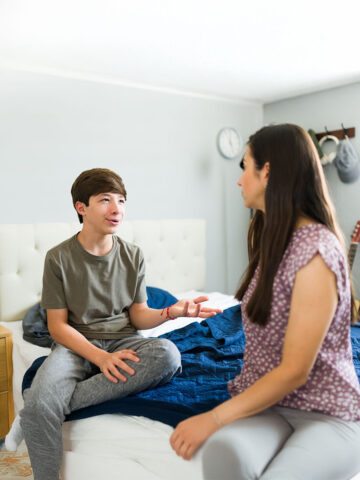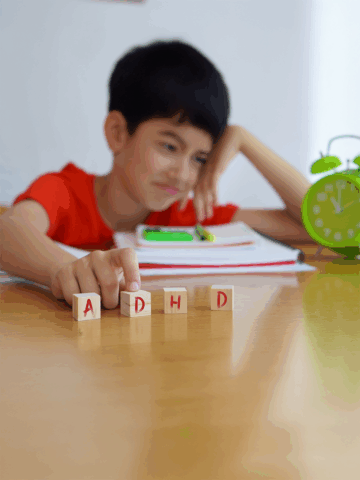According to the Centers for Disease Control and Prevention (CDC), from 2016 to 2019, approximately 2.7 million children ages 3 to 17 have been diagnosed with depression. Because of this, parents may either have a child dealing with depression or likely will know a child or teen dealing with depression.
In a recent webinar for CHOC’s Mental Health Education Program, Dr. Shirin Mostofi, pediatric psychologist, provided helpful strategies for parents to check in with their kids and teens.
“Adults can provide important emotional support for the kids and teens in their lives. They can help reduce the likelihood of developing depression, or help kids with depression get the support and help they need,” says Dr. Mostofi.
What are the signs of depression?
Although symptoms of depression vary from child to child, there are signs that parents can keep a look out for in kids and teens. It’s also important to keep in mind that some symptoms of depression can be internal, and not as easy to spot.
Some typical external symptoms associated with depression:
- Loss of interest.
- Down, sad or depressed mood.
- Fatigue.
- Decreased concentration.
- Expressed thoughts about death (suicidal ideations).
- Changes in weight and/or sleep.
- Slowing down of physical movement
Some of the symptoms associated with depression might also be internal, and not as easy to notice, such as:
- Overthinking situations in the past.
- Having a hard time focusing – which may look like daydreaming.
- Thoughts of being a burden on others so not asking for help when needed.
- Thoughts of life never getting better or changing.
- Feelings of loneliness and not being accepted.
- Feelings of worthlessness and/or guilt.
- Unexpressed suicidal thoughts.
- At times, self-harm behaviors are unnoticed as well.
Read CHOC’s guide to depression for more symptoms to watch for and strategies for helping your child.
What leads to depression?
Depression is one of the most common mental health disorders in the U.S. There’s no one event or cause of depression, but there are risk factors that may increase the likelihood of someone developing depression, says Dr. Mostofi.
One, or the combination of a few risk factors, may cause a young person to develop depression:
- Family history of depression.
- Major life changes, trauma or stress.
- Certain physical illnesses or medications.
Helpful support for someone with depression or at risk of depression
How to help to decrease the risk of depression in kids and teens
Being aware of contributing factors to depression increases our awareness. If parents and trusted adults can spot signs and symptoms of depression, they can spring into action — increasing protective factors, or strategies, to help lessen the risk of developing depression, and providing important help and support for their kids who may already have depression.
Protective factors help kids build their strength, support and resilience, or the ability to bounce back from feelings of depression.
To increase protective factors for depression in kids and teens, you can help the kids and teens in your life:
- Find the magic in every day.
- Connect with resources in family, community, relationships and environment.
- Make sure they have at least one positive relationship in their lives. This can outweigh several risk factors that may lead to depression.

Mental Health Education Program (MHEP) webinars
How you can support a child in your life with depression
Check-in with a child or teen in your life, and model that same behavior as an example for them.
Sometimes kids might have a hard time reaching out when they need help. When you check in, they will know that you love and care about them and are paying attention to them. By modeling, they’ll know that you also are human and may need help sometimes.
Here are some things parents can say to check in and model for kids and teens, says Dr. Mostofi:
- “I’m seeing an expression on your face right now that looks different than before; am I picking up on something?”
- “I think there may be something pre-occupying your mind, would you like to share?”
- “What were the best and worst parts of your day?” Follow up with your best and worst moments.
- “Some days are much harder than others, is today one of those for you?”
- “Is there some way I can be there for you right now?”
- “Was something hard about today that you’d like to share?”
- “I could’ve done without (e.g. my boss criticizing me today); what was one thing you would’ve liked to do without?”
- “Looking back at my day, I would’ve liked to (e.g. handle that confrontation with my friend better, it’s taking up a lot of space in my mind). What’s something that’s taking up space in your mind?”
After these check-in and modeling strategies, if the child or teen starts to open up to you, be sure to:
Allow them space to talk.
“We refer to this as validation”, says Dr. Mostofi. To validate is to sit in the moment with the emotions, challenges, and hardship presenting in front of you. By doing so, you can help people feel comfortable to talk and share more about how they feel. This can help them know it’s OK to open up – depression can be a lonely place.
Avoid jumping into “fix it” mode.
Coming up with a solution for the child’s struggles or emotions may be the natural first response for parents. After all, as caregivers, the impulse is to take care of children by making the awful things in their lives “go away”. Kids and teens often will shut down with this initial response from their parents and other adults in their lives because they just want to feel heard and listened to instead.
Kids and teens more commonly share their emotions and struggles with their friends because they’re more likely to get the empathic responses they want, such as, “Aww man, that sucks!” or “I can’t believe that happened to you!” rather than solutions they may receive from adults.
Of course, the goal is to provide the child with long-term support and solutions to help them thrive, and starting with the practice of deeply and wholeheartedly listening to them first, may lead to a better connection, relationship, and changes that parents frequently seek.
Say this, not that for successful check-ins with your kids
Dr. Mostofi offers some scenarios for parents to practice checking in, listening and avoiding “fix it” mode.
Your child failed a test that they spent a lot of time preparing for.
Say this first: “Oh failing an exam can be so heartbreaking, especially after trying so hard or wanting a better grade.”
Not that: “Oh no, you failed an exam, we can get a tutor and talk to your teacher.”
Your child is overwhelmed by all of their schoolwork and after-school activities
Say this first: “You’re feeling the pressure of it all right now, and it’s a heavy weight to carry. Things don’t look so bright at the moment.”
Not that: “Well, things don’t always last, and they usually get better.”
Your child isn’t acting like their usual self and seems down
Say this first: “Feeling sad or devastated is part of a loss. You want things you don’t have or wish things were different.”
Not that: “Don’t be sad, there’s nothing you can do about it.”
How to help your child feel and handle their emotions
Have emotional check-ins with your kids
Emotions are powerful. Although they may begin just as thoughts, they can quickly lead to actions.
To have emotional check-ins with your kids, Dr. Mostofi suggests asking them the following questions:
- “How are you feeling today/right now?”
- “What are some emotions you are experiencing?”
- “I’m feeling (this emotion) right now, how about you?”
Try to notice and overcome any of your own challenges for emotional check-ins
Sometimes, a parent’s own emotions may get in the way of asking about their child’s well being. By checking in, you can show your kids that you are there for them.
Challenges to emotion check-ins for adults/caregivers:
- Not taking a keen eye to notice shifts in emotions from the child.
- Your own habits of not attending to your own emotions.
- Fear of not knowing what to do about the child’s response.
- Being task- and to-do list-focused.
- An “It’s a phase mentality” for kids’ behavior or emotions.
It’s important to be effortful with trying to overcome these challenges to check in with the kids and teens in your lives! By talking through difficult emotions with your kids, you may be able to express some of yours, too.
How to support your child down when emotions are high
During your emotional check-ins, you may run into some intense emotions from your child, or yourself!
So, what do you do when emotions are high?
If your child feels an emotion at a high intensity – sadness, anger or any other emotion— that means that they are consumed by that emotion at the moment. They may be having a hard time doing anything else; their actions and words will highly likely all be emotion based for the time being.
It’s important to help them regulate their emotions so they can make good decisions and manage their reactions. It won’t fix the situation that is causing the intense emotions, and it can deescalate the response to the situation, or prevent the response from escalating even further. The following can help your child reduce the pent-up emotions in their bodies.
Feeling cold can help your child when their emotions are intense, so have them try the following:
- Taking a cold shower.
- Putting an ice bag on their face, front and back of their neck, armpit or hands.
- Have them do an “ice dive” or submerge their face into cool, ice water.
- Go swimming.
Intense exercise can also help your child deescalate and feel endorphins. The following exercises can help:
- Jumping jacks.
- Burpees.
- Skipping.
- Jump rope (or pretend).
Or try coping techniques such as progressive muscle relaxation for younger kids and older kids and or paced breathing.
Try at least two of the mentioned methods, if not willing to all four, for one minute each, to help your child calm down and feel better (even if a little).
Other general support for helping your child express themselves
In addition to check-ins and modeling, Dr. Mostofi suggests the following additional ways to support your child or teen:
Identify other trusting adults
Try asking your child, “Is there someone else that would be helpful to spend some time with?”
Or, determine some people in your lives that your child may feel comfortable talking to, besides people who live in your home. Pinpoint people who can support them at school. Maybe it’s a counselor, a certain teacher, a principal, a nurse, someone from the environmental services staff or a security guard.
Engage in activities together
The first step is to know and identify activities of interest. How can you be there to help distract them from intense emotions that are becoming impairing, overwhelming or dysfunctional?
The second step is to have one-on-one time doing these activities daily. Try asking your child,
- “Would you like some special fun time right now for a bit?”
- “Maybe you’re not feeling like doing anything right now, but I know you like to (e.g. cook, listen to music, go window shopping, work on a puzzle, watch a certain tv show). Let’s do that in a bit.”
- “What is one thing that may improve your mood?”
Distraction, at times, can be so helpful! Of course, distraction is good for temporary relief, not a long-term solution, says Dr. Mostofi.
Other strategies for helping kids with depression or at risk for depression
For other strategies to help kids and teens with depression or to lower the risk of developing depression, Dr. Mostofi suggests the following:
- Physical activity – the American Academy of Pediatrics (AAP) recommends at least 60 minutes of moderate to vigorous physical activity for children 6 years and older on most days of the week. 60 minutes of the following can serve as protective factors for depression in kids:
- Walks
- Physical Education (PE)
- Biking
- Yoga or Zumba
- Any other movement!
- Socializing (e.g., family activities, dinner/meal routines, social events, etc.).
- Having a routine.
- Going to a psychologist or psychiatrist.
- Visiting your pediatrician or primary care provider.
- School support (counselor, accommodations).
- Parents and kids working together for their treatment.
Depression is a challenging struggle and can be very common in kids and teens. Although there are many factors that can lead to risk of depression, collaborative, consistent and extensive support is the most beneficial. There are several different ways to receive support as outlined above, and parents and teens can always seek help when they are unsure of what to do. “You are not alone!” Says Dr. Mostofi.
Crisis Resources
If your child expresses thoughts of wanting to harm themselves or others, call 9-1-1 or visit the nearest emergency department.
988 Suicide and Crisis Lifeline:
Call 9-8-8
Text any message to 9-8-8
Chat online at 988lifeline.org/chat
Crisis Text Line:
Text “HOME” to 741741
Get more expert health advice delivered to your inbox monthly by subscribing to the KidsHealth newsletter here.
Get mental health resources from CHOC pediatric experts
The mental health team at CHOC curated the following resources on mental health topics common to kids and teens, such as depression, anxiety, suicide prevention and more.





